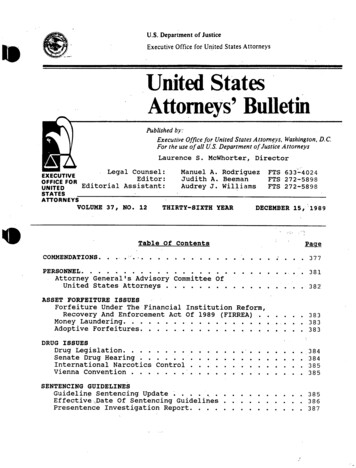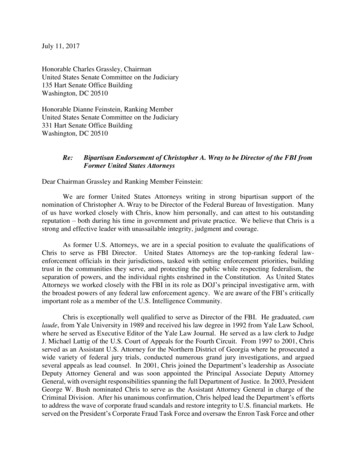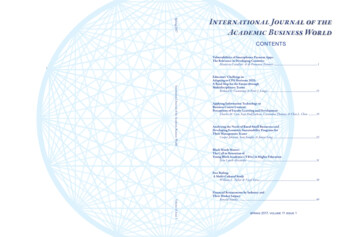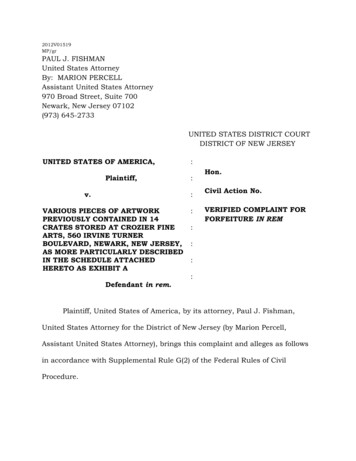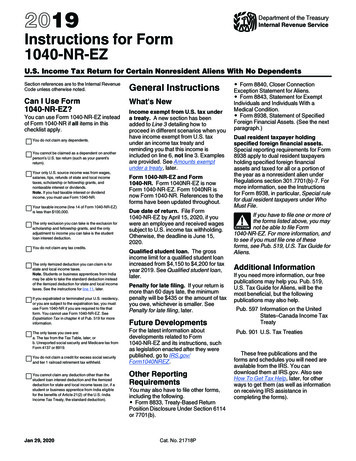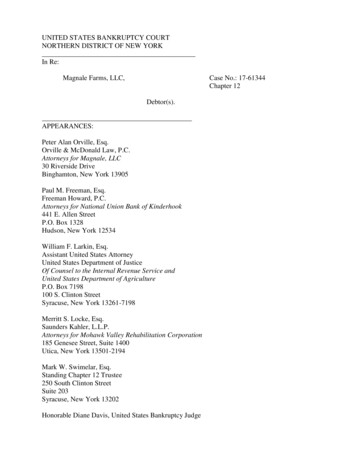
Transcription
UNITED STATES DEPARTMENT OF STATEBUREAU OF DIPLOMATIC SECURITY2011
2011TABLE OF CONTENTSDiplomatic Security Overview . . . . . . . . . . . . . . . 2Introduction . . . . . . . . . . . . . . . . . . . . . . . . . . . . . . . 3A Statistical Overview of 2011 . . . . . . . . . . . . . . . 4LISTING OF ACRONYMSIN THIS REPORTAmericans Killed or Injured inTerrorist/Politically Motivated Violence . . . . . . . 5Americans in Captivity . . . . . . . . . . . . . . . . . . . . 5Incidents of ViolenceWestern Hemisphere . . . . . . . . . . . . . . . . . . . . . . . 6Europe . . . . . . . . . . . . . . . . . . . . . . . . . . . . . . . . . . 8Near East . . . . . . . . . . . . . . . . . . . . . . . . . . . . . . . 12South and Central Asia . . . . . . . . . . . . . . . . . . . . 20East Asia and the Pacific . . . . . . . . . . . . . . . . . . . 24Conclusion . . . . . . . . . . . . . . . . . . . . . . . . . . . . . . . 26DSBureau of Diplomatic SecurityEFPExplosive Formed PenetratorsIDFIndirect FireIEDImprovised Explosive DeviceLGFLocal Guard ForceNGONon-Governmental OrganizationVBIEDVehicle-Borne ImprovisedExplosive Device
A TEAM MEMBER OF DIPLOMATIC SECURITY’S OFFICE OF MOBILEsecurity DEPLOYMENTS KEEPS WATCH FROM HIS PERCH IN AHELICOPTER. (U.S. DEPARTMENT OF STATE PHOTO)The Bureau of Diplomatic Security (DS) isthe law enforcement and security armof the U.S. Department of State, providing asecure environment for the conduct of American diplomacy.To advance American interests and foreign policy, DSprotects people, property, and information at more than280 State Department missions worldwide. As a leader ininternational investigations, threat analysis, cyber security,counterterrorism, dignitary protection, and securitytechnology, DS is the most widely represented U.S. securityand law enforcement organization in the world.2 I DIRECTORATE OF THREAT INVESTIGATIONS AND ANALYSISPolitical Violence Against Americansis produced by the Bureau’s Directorate of ThreatInvestigations and Analysis (DS/TIA) to provide readerswith a comprehensive picture of the spectrum of politicallymotivated threats and violence that American citizens andinterests encounter worldwide on an annual basis. Createdin May 2008, the Directorate of Threat Investigations andAnalysis strives to improve Diplomatic Security’s ability todetect and counter threats, and to upgrade the Bureau’scapacity to rapidly disseminate threat and securityinformation to our embassies, consulates, and the U.S.private sector.
2011INTRODUCTIONThe global threat environment remainsdangerous and unpredictable. In an effortto advance political and ideological causes, and to disruptstatus quo interests and institutions, extremist groups andindividuals of every stripe utilize a broad array of methodsand venues to terrorize, injure, and kill priority targets,while seeking to foment disturbances and chaos withinsociety more generally.Political Violence Against Americans is a report to theAmerican people that focuses on major incidents ofanti-U.S. violence and terrorism, with apparent politicalmotivations, that occurred worldwide during 2011. TheU.S. Department of State closely monitors and maintainsinformation on threats to Americans overseas – fromterrorism and organized violence, to street crimes andhealth hazards – and makes this information freelyavailable. It is the policy of the U.S. Government that nodouble standard shall exist regarding the dissemination ofthreat information that affects U.S. citizens. Governmentemployees may not benefit unfairly by access to, orpossession of, privileged information that applies equallyto all Americans.In view of the enormous number of hostile incidents thatoccur universally in the course of a year, the particularevents cited in Political Violence Against Americans wereselected based upon certain specific criteria in additionto their political nature, including one or more of thefollowing: the presence of casualties, substantial propertydamage, or the use of unusual tactics and weapons,together with a perception of the targets as intentionallythose of the United States or representative of U.S.interests. The incidents included here were reportedto Department of State Diplomatic Security personnelposted at U.S. missions worldwide, and comprise thebest information (sometimes incomplete) that is available.Some incidents are never reported to U.S. officials, ofcourse. A few unique incidents have been omitted dueto their sensitive nature, as have the names of Americancitizens for privacy purposes.A Special Note RegardingAfghanistan and IraqCompiling a comprehensive chronology of anti-Americanviolence in the war zone environments of Afghanistanand Iraq presents unique challenges. Given the complexsecurity context within both countries, it is understandablydifficult to obtain detailed, reliable information on everyincident involving Americans and sometimes nearlyimpossible to distinguish acts of targeted political violenceand terrorism from general war zone hazards. Recognizingthis, we have limited our reports of incidents inAfghanistan and Iraq to those involving targets under U.S.Chief of Mission authority. In addition, instances of rocketand mortar attacks against U.S. diplomatic facilities areincluded only when they resulted in casualties or propertydamage. This criteria provides a practical standard forlisting assaults most relevant to this report.POLITICAL VIOLENCE AGAINST AMERICANS 2011 I 3
A STATISTICAL OVERVIEWOF 2011Of the 79 incidents that involved U.S.citizens and interests, 78 are believedto have resulted from intentionaltargeting of Americans. The oneincident where Americans or Americaninterests apparently were not involveddue to nationality is indicated with anasterisk (right) and in the East Asia andthe Pacific section.Western Hemisphere Affairs (WHA)2U.S. GovernmentEurope (EUR)1U.S. Business2U.S. Government1U.S. MilitaryNear East Asia (NEA)50U.S. Government4 I DIRECTORATE OF THREAT INVESTIGATIONS AND ANALYSISAREAS OF INCIDENTSINVOLVING AMERICANS2Western Hemisphere4Europe0Sub-Saharan Africa43Near East9South and Central Asia14*East Asia and the PacificSouth and Central Asia (SCA)1U.S. Business7U.S. Government1U.S. MilitaryEast Asia and the Pacific (EAP)11U.S. Business2U.S. Government1Other
AMERICANS KILLED OR INJURED INTERRORIST/POLITICALLY MOTIVATED VIOLENCE*January 25 – Manila, Philippines:A bomb explodedaboard a local bus. Five persons were killed in theexplosion. Among the injured was a dual-nationalityPhilippines-U.S. citizen.February 27 – Baghdad, Iraq:While stopped in traffica member of the U.S. Protective Security Detail wasstruck with a projectile in his hand and required surgeryin the U.S.March 2 – Frankfurt, Germany:A lone gunmanapproached a U.S. Air Force bus parked at FrankfurtInternational Airport and opened fire on the passengers.Two U.S. servicemen were killed and two more wereinjured. The assailant was immediately subdued andturned over to German authorities.March 26 – Caracas, Venezuela: During a violentdemonstration at the U.S. Embassy, two Embassyofficers were physically attacked while tryingto move the Embassy guards away from theprotesters and Embassy wall. One of the officerswas slightly injured.August 3 – Baghdad, Iraq:A Protective Security Detailteam supporting the Bureau of International Narcoticsand Law Enforcement Affairs was attacked by an IED ata venue. Two U.S. advisors were injured, one seriously.One interpreter was killed, and two others were injured.September 25 – Kabul, Afghanistan: An Afghanemployee opened fire inside a U.S. Embassy Annexcompound. The gunman killed one American assignedto the Embassy and wounded three others before beingshot and killed.December 2 – Mohammad Agha District, LogarProvince, Afghanistan: At least one VBIED explodedat the entry point of Combat Outpost McClain. OneAmerican was slightly injured in the attack.December 16 – Kabul, Afghanistan: Two U.S.contractors with the DEA were fixing a flat tire alongsidethe road when the driver of a passing truck threw a handgrenade at the contractors. One sustained shrapnelwounds and was treated for his injuries at a hospital andreleased. The other contractor was not injured. No oneclaimed responsibility for the attack.May 20 – Peshawar, Pakistan: Two U.S. ConsulateGeneral officers suffered minor injuries when theirvehicle sustained heavy damage from a vehicleborne improvised explosive device (VBIED) parkedalong their route.June 6 – Helmand Province, Afghanistan: A helicoptertransporting Drug Enforcement Administration(DEA) personnel was hit with approximately sixrounds of small arms fire. One DEA agent waswounded and transferred to a nearby InternationalSecurity Assistance Force facility and was treatedfor his injuries.June 23 – Baghdad, Iraq: An explosively formedprojectile targeted a Protective Security Detail as itwas en route from the University of Baghdad. OneAmerican was killed and another suffered injury tothe neck.AMERICANS IN CAPTIVITYAugust 13 – Lahore, Pakistan:Armed militantskidnapped a U.S. citizen from his home. The victim is aconsultant with the Pakistani office of an American firm,J.E. Austin Associates. Al-Qaida later released a videoclaiming to be holding the hostage. As of this report,the U.S. citizen remains missing.* Excepting those involved in the January 25,March 2, and December 16 incidents, victims areU.S. government employees functioning underauthority of an embassy’s Chief of Mission.POLITICAL VIOLENCE AGAINST AMERICANS 2011 I 5
WESTERNHEMISPHEREINCIDENTS OF VIOLENCEWESTERN HEMISPHERECountries with Anti-American Incidents1Chile1VenezuelaTargets of Anti-American Incidents2GovernmentTypes of Anti-American Incidents1Bomb1Violent demonstrationMarch 21 – Vina Del Mar, ChileA small explosive device detonated outside the U.S. BinationalCenter. The explosion caused minor damage but no one wasinjured in the attack. The bombing occurred hours prior toU.S. President Barack Obama’s arrival. No group has claimedresponsibility for the attack.March 26 – Caracas, VenezuelaAt approximately 12 p.m., a group of 15 to 20 demonstratorsgathered across the street from the U.S. Embassy to protestU.S. involvement in Libya. By 1 p.m., the group had grownto more than 100 persons, many equipped with spray paint,megaphones, placards, and projectiles that included eggs androck-filled shoes. By 1:45 p.m., protesters were spray-paintinggraffiti on the principal Embassy wall. Two Embassy officerswere physically attacked while trying to move the Embassyguards away from the protesters and Embassy wall. One ofthe officers was slightly injured. During the demonstrationprotesters also burned an American flag, spray-painted thestreet and sidewalk with anti-American slogans, and threw eggsand rock-filled shoes at the Mission.At approximately 2:15 p.m., thedemonstrators began dispersing anddeparted the area. At 2:30 p.m., alllocal police personnel also departedthe area of the Embassy.March 21 – Vina Del Mar, Chile: A GROUP OFABOUT 100 PROTESTORS BURN A U.S. FLAG OUTSIDETHE GOVERNMENT PALACE LA MONEDA IN SANTIAGO,WHERE PRESIDENT OBAMA WAS BEING HONOREDWITH AN OFFICIAL STATE DINNER. OBAMA waS INCHILE AS PART OF A THREE-COUNTRY, FIVE-DAY TOUROF LATIN AMERICA. (AP/WIDE WORLD)6 I DIRECTORATE OF THREAT INVESTIGATIONS AND ANALYSIS
March 26 – Caracas, Venezuela: FOR TWO HOURS,DEMONSTRATORS IN CARACAS, VENEZUELA, POUNDED THE WALLOF THE U.S. EMBASSY WITH FISTS AND IMPLEMENTS, THEN LEFT ITSPATTERED WITH SPRAY-PAINTED SLOGANS. (U.S. DEPARTMENT OFSTATE PHOTOs)POLITICAL VIOLENCE AGAINST AMERICANS 2011 I 7
EUROPEINCIDENTS OF VIOLENCEEUROPECountries with Anti-American iaTargets of Anti-American Incidents1Business2Government1MilitaryTypes of Anti-American Incidents1Armed assault1Bomb1Molotov cocktail1Murder8 I DIRECTORATE OF THREAT INVESTIGATIONS AND ANALYSISMarch 2 – Frankfurt, GermanyAt approximately 3:22 p.m., a suspicious individual approached aU.S. Air Force (USAF) enlisted man who was in civilian attire andasked for a light for his cigarette. The U.S. Airman was one of 15who had arrived at Frankfurt International Airport from London,U.K., and was loading onto a marked USAF bus. The subject thenmoved to a position behind the bus and loitered for a few minutes.He then returned to where the U.S. Airman was standing, walkedbehind him, pulled a 9mm pistol, and shot him point-blank in theback of his head. The subject then quickly moved to the door ofthe bus, boarded, and shot the driver -- who was in USAF uniform -point-blank in his temple. The shooter then fired at two other USAFpersonnel, critically wounding them, and was attempting to fire onanother airman when his gun jammed. After several unsuccessfulattempts to clear the weapon, the subject fled the bus and raninside the terminal with his intended fifth victim in hot pursuit.The shooter was eventually confronted by German Bundespolizei(Federal Police) and taken into custody. He was later identified as aKosovar Albanian and tried for murder in a proceeding that beganon August 31, 2011. The German federal prosecutor demanded lifein prison for the suspect during the January 9, 2012, session of thetrial. On February 10, 2012, the Frankfurt Higher Regional Courtsentenced the shooter to life in prison (the most severe punishmentavailable under the German Criminal Code) after finding him“gravely guilty” of two murders and three attempted murdersduring his assault on USAF personnel transiting Frankfurt. UnderGerman law, most life sentences allow for the possibility of paroleand re-socialization after 15 years. Due to the finding of “particularlygrave guilt,” however, parole will not be available at the usual15-year mark. The judge in the case stated that “any reduction ofprison time seems inappropriate.”
March 2 – Frankfurt, Germany: IN THIS MARCH 2, 2011, PHOTO, POLICE INVESTIGATE THE SCENE AFTER A GUNMANFIRED SHOTS AT U.S. airmen ON THE BUS OUTSIDE FRANKFURT AIRPORT, GERMANY. (AP/WIDE WORLD)March 2 – Frankfurt, Germany: BULLET HOLEs areSEEN IN THE DRIVER’S WINDOWs AS THE BUS IS TOWEDAWAY AFTER A GUNMAN FIRED SHOTS ON THE BUSOUTSIDE FRANKFURT AIRPORT, GERMANY, MARCH 2, 2011,KILLING TWO AIRMEN AND WOUNDING TWO BEFOREBEING TAKEN INTO CUSTODY. (AP/WIDE WORLD)POLITICAL VIOLENCE AGAINST AMERICANS 2011 I 9
October 28 – Sarajevo, Bosnia-Herzegovina:Glass at the front of Embassy Sarajevo wascracked but not penetrated when a gunmanattacked the building. (U.S. Department ofState photo)“A man with a Kalashnikov rifleopened fire on the U.S. Embassycompound from Zmaja odBosne, the main road.”10 I DIRECTORATE OF THREAT INVESTIGATIONS AND ANALYSIS
October 28 – Sarajevo, Bosnia-HerzegovinaAt approximately 3:45 p.m., a man with a Kalashnikov rifle opened fireon the U.S. Embassy compound from Zmaja od Bosne, the main roadin front of the new Embassy. Multiple rounds impacted against theballistic-resistant windows and walls of the Embassy. An eyewitnesslater stated that the gunman shouted anti-American and proChechen statements. The responding local SWAT unit engaged andwounded the gunman. A policeman also was injured in the attack. At4:15 p.m., local police apprehended the gunman and discovered twogrenades on his person. Police also arrested two individuals believedto be accomplices in the attack and discovered three additionalgrenades in a bag near a red Opel Kadett automobile associatedwith the suspects.November 30 – Tallinn, EstoniaAt approximately 5:52 p.m., a 19-year-old Estonian man threw aMolotov cocktail at the front of the U.S. Embassy. The fire wasimmediately extinguished and the suspect was apprehended andturned over to the police. There were no injuries to U.S. personneland no damage to the Mission. According to the police, the suspectwas angry with America and thought if he threw the homemadefirebomb the Americans would leave Estonia.December 28 – Kosice, eastern SlovakiaAt approximately 5:30 p.m., a small improvised explosive device(IED) detonated outside a McDonald’s restaurant. The explosionresulted in no deaths or injuries though minor property damage wasreported. Through their investigation the Slovak police identified andsubsequently arrested one suspect who remains in detention.October 28 – Sarajevo, BosniaHerzegovina: A MAN WITH ANASSAULT RIFLE fires ROUNDS TOWARDTHE U.S. EMBASSY IN SARAJEVO, BOSNIAHERZEGOVINA. BOTH THE GUNMAN ANDa POLICE OFFICER WERE WOUNDED. (U.S.DEPARTMENT OF STATE PHOTOs)POLITICAL VIOLENCE AGAINST AMERICANS 2011 I 11
near eastINCIDENTS OF VIOLENCENEAR EASTCountries with Anti-American Incidents42Iraq2Yemen3Egypt1Libya2SyriaTargets of Anti-American Incidents50GovernmentTypes of Anti-American Incidents1Ambush1Attempted armed attack1Attempted grenade35Indirect fire3Violent demonstration4Small arms fire4Bombs1Embassy destruction12 I DIRECTORATE OF THREAT INVESTIGATIONS AND ANALYSISJanuary 1 to December 31— IraqThreats of attack against U.S. citizens throughout Iraqcontinued in 2011, including in the International Zone ofBaghdad. Chief of Mission personnel in Iraq faced numerousthreats including attacks that employed improvised explosivedevices, explosively formed penetrators, and indirect fire. AllU.S. Government employees under the authority of the U.S.Ambassador continue to follow strict safety procedures whentraveling outside the Embassy.There were 35 reported incidents of indirect fire targeting theU.S. Embassy in Baghdad as well as a number of additionalindirect-fire incidents targeting U.S. interests in other areasof Iraq. Causalities and destruction of property are oftenthe result of these attacks and, in many instances, themunitions impact outside the security zones into surroundingneighborhoods.January 4 – Baghdad, IraqAs members of the Chief of Mission’s protective security detail advanceteam were at the Ministry of Justice, they came under small arms fire.The team returned safely to the U.S. Embassy. No one was hurt in theattack, and there was no damage to Embassy property.January 11 – Sanaa, YemenAt approximately 8:46 p.m., as the U.S. Deputy Chief of Mission wasreturning from the airport after the departure of the Secretary of State,an unknown person crouching on the side of the road near a pedestrianbridge threw a large rock or brick at her SUV. There were no injuriesto Embassy personnel or the local police escort. There was superficialdamage to the right front quarter panel of the SUV where the objectimpacted.
February 3 – Cairo, EgyptAt approximately 4:23 p.m., a U.S.Embassy shuttle van encounteredangry mobs of 30 to 40 protesters.As the vehicle slowly proceededsouthbound on the Corniche ElNil, protesters attempted to blockit, demanded that the passengersget out, and attempted to pryopen the doors and armoredglass of the armored vehicle. Theyalso punctured the tires of thevehicle, but it was still operable.Negotiations by the driver were unsuccessful. The van continuedsouthbound, where it encountered a second crowd, this one moreagitated than the previous, and whose members struck the vanrepeatedly. After passing through, the van reached a third mob in thegauntlet. This time protesters, frustrated by their lack of success inextracting the passengers, started to hit the bullet-resistant windowswith long knives, sticks, and rocks. Some of the protesters evenbrandished firearms and climbed atop the vehicle. The gangs seemedto focus exclusively on this vehicle, ignoring most others around it.Each time, however, the driver pressed ahead successfully. By thetime the van arrived at its destination, it had sustained damage to twowindows, but none of its passengers were injured.Baghdad, Iraq: U.S. EMBASSY BAGHDAD –INSIDE THEinternational zone BUT STILL FORTIFIED AGAINST THEPERSISTENT THREAT OF INCOMING FIRE. (U.S. DEPARTMENTOF STATE PHOTO)February 3 – Cairo, EgyptAt 4:45 p.m., four or five shots were fired from a northerly direction, oneof which impacted the north wall of the U.S. Embassy. It is not knownwhether the Embassy was the intended target or hit by random fire.February 20 – Baghdad, IraqA Protective Security Detail advance team conducting a mission to theMinistry of Health received small arms fire that wounded an Iraqi policeofficer riding in the Chief of Mission motorcade. The officer wasseated in the well of the last vehicle – an armored Chevrolet Suburban– at the time.February 27 – Baghdad, IraqAt approximately 11:57 a.m., a Protective Security Detail wasconducting an advance mission at the Ministry of Science andTechnology when, while stopped in traffic, the well gunner was struckwith a projectile in his hand and required surgery in the U.S.Cairo, Egypt: a ds Deputy Regional SecurityOfficer monitors disturbances in thestreets below from atop the U.S. Embassyalong with a U.S. Marine, February 2011. (U.S.Department of State photo)POLITICAL VIOLENCE AGAINST AMERICANS 2011 I 13
February 3 – Cairo, Egypt:the ds deputy regionalsecurity officer (seenthrough the window)and assistant regionalsecurity officer (right)check the vehicleidentification number onan armored passengervan stolen from a u.s.embassy parking lot andset on fire during massivecivil unrest in the city.(U.S. DEPARTMENT OF STATEPHOTO)March 28 – Baghdad, IraqAt approximately 8:43 a.m., an IED exploded at the intersection of Buzzand Caranac near the Al-Shaab (Olympic) Stadium. At the time of theincident, an International Narcotics and Law Enforcement DynCorpInternational Protective Security Detail was passing through theintersection. The lead motor vehicle suffered minor damage as a resultof the detonation. No detail members were injured. A total of five IEDsdetonated in that area between the hours of 6 a.m. and 9 a.m.May 1 – Tripoli, LibyaCairo, Egypt: FROM THE ROOF OF THE U.S.EMBASSY, DS AND OTHER EMBASSY PERSONNELCOULD VIEW THE MASSIVE STREET PROTESTS INTAHIR SQUARE, AS IN THIS PHOTO TAKEN ONFEBRUARY 2, 2011. (U.S. DEPARTMENT OF STATEPHOTO)14 I DIRECTORATE OF THREAT INVESTIGATIONS AND ANALYSISAt approximately 2:45 a.m., uniformed members of the Libyan militaryscaled the Embassy compound’s perimeter walls. The individuals,armed with automatic weapons, began shooting at doors, windows,security cameras and alarms during their efforts to breach thecompound’s interior buildings. Several of the buildings were set on fireby the intruders. Five Embassy guards on duty were forced to evacuatethe compound. A review of the Embassy’s security camera footagerevealed that forces utilized various weapons, as well as industrialtools, to include cutting torches, to gain access to all of the Embassybuildings. At approximately 10 a.m., several hundred demonstratorsstormed the Embassy, looting and destroying the remaining U.S.Government property. The mob opened the vehicle gates of thecompound, drove tow trucks onto the grounds and removed allEmbassy vehicles, both official and personal, from the compound. Agreen Libyan flag was raised over the U.S. Embassy.
Tripoli, Libya: Nearly fourand a half months afterthe U.S. Embassy in Tripoliwas ransacked and setafire by a mob, newscrews were allowedinside to see the damage.The U.S. Embassy wasone of several Westerndiplomatic posts thatwere attacked by angryLibyans on May 1, 2011. Thevandalized buildings wereempty at the time of theassaults and no injurieswere reported. (AP/WIDEWORLD)May 1 – Tripoli, LibyaLibyan military personnel stormed the General Service Office (GSO)warehouse and drove trucks onto the warehouse compound and stoleU.S. Government property. Members of the U.S. Embassy’s local guardforce were forced to evacuate to adjacent properties. When the Libyanforces departed the GSO warehouse, other Libyans followed in theirwake and looted the warehouse. The Ambassador’s and Deputy Chiefof Mission’s residences were also stormed, damaged, and looted bymembers of the Libyan Revolutionary Guards.May 2 – Cairo, EgyptA man approached a local police officer standing outside the U.S.Embassy and attempted to steal his weapon. The man’s statedintention was to take revenge for the death of Osama bin Laden byattacking a foreign mission.June 6 – Baghdad, IraqAt approximately 8 a.m., a Protective Security Detail was traveling inBaghdad and had just passed Gray 146 en route to a venue (Al ElwiyahClub) when approximately 200 meters northeast, the motorcade was hitby an IED. The motorcade consisted of four vehicles. The lead vehiclereceived extensive damage as a direct result of the explosion. As anindirect result of the explosion, the K-9 vehicle and the EmergencyReact Vehicle received extensive damage caused by a collisionbetween the two vehicles. The fourth motor vehicle in the motorcadereceived no damage. No injuries were reported as a result of thisincident.may 1 – Tripoli, Libya: The ballistics-resistant glassinstalled in the doorways at Embassy Tripoli’sconsular offices withstood the fury of an enragedLibyan mob before finally giving way to invaders whotrashed and burnt this and other buildings in thecompound. (U.S. DEPARTMENT OF STATE PHOTO)POLITICAL VIOLENCE AGAINST AMERICANS 2011 I 15
June 23 – Baghdad, IraqA Sallyport Protective Security Detail supporting a USAID implementingpartner was en route from the University of Baghdad when it was struckby an explosively formed projectile. One American was killed andanother suffered an injury to the neck.July 8 to July 11 – Damascus, SyriaFollowing the highly publicized trip of U.S. Ambassador Robert Fordto meet with opposition figures in Hama, Syria, on July 7, 2011, progovernment supporters began to gather in front of the U.S. Embassyon July 8, 2011, at 4 p.m. to demonstrate their opposition to thevisit. Roughly 150 demonstrators carrying signs and shouting antiU.S. slogans congregated outside the U.S. Embassy. By 5:40 p.m.,the number had increased to approximately 300 persons. Althoughinitially peaceful, the situation turned volatile as the crowd beganthrowing eggs, tomatoes, bottles containing red paint, and rocks atthe Main Compound Access Control facility and the perimeter wallof the Embassy. Demonstrations continued for three days, climaxingon July 11, 2011, when buses arrived with more than 500 additionaldemonstrators. Syrian security forces were outnumbered and illprepared to prevent the growing mob from reaching the primaryentrance and perimeter wall of the U.S. Embassy. Armed with sticks,rocks, and other makeshift weapons, the mob began to break ballisticglass and climb over the exterior fence. Once atop the main entrance,intruders smashed security cameras and attempted to set fire tothe roof. As the mob roared approval from below, evidently skilledclimbers scaled the Chancery walls and then climbed theflagpole where they removed the American flag and replaced it withthe Syrian flag.Not only did this mob attack the U.S. Embassy, but also the Chief ofMission residence, where they destroyed two armored vehicles and anunarmored box truck. After several hours, Syrian security forces thatwere responsible for protecting the embassy removed the intruders andpushed back the crowds, but the damage left behind was extensive.Despite the mayhem, no staff members were injured.July 8 to July 11 – Damascus, Syria: U.S.EMBASSY DAMASCUS VEHICLES WERE DAMAGEDWHEN A PRO-GOVERNMENT MOB ATTACKED. (U.S.DEPARTMENT OF STATE PHOTOs)16 I DIRECTORATE OF THREAT INVESTIGATIONS AND ANALYSISAugust 3 – Baghdad, IraqAt 9:10 a.m., a DynCorp International Personal Security Detail teamsupporting the Bureau of International Narcotics and Law EnforcementAffairs was hit by an IED at a venue. Five injuries were reported as aresult of this incident and one DynCorp International vehiclewas damaged.
July 8 to July 11 – Damascus, Syria: on july 11, pro-government demonstrators climbthe wall and the flagpole of the u.s. embassy compound in damascus, syria, replacingthe u.s. flag with their own and damaging embassy property. they also attacked the u.s.ambassador’s residence, two blocks away. the mobs were later dispersed. (private collection)July 8 to July 11 – Damascus,Syria: PROTESTERS HANG A HUGESYRIAN FLAG AT THE ENTRANCEOF THE U.S. EMBASSY COMPOUNDAS THEY PROTEST AGAINST u.s.AMBASSADOR ROBERT FORD AFTERHIS VISIT TO THE SYRIAN CITY OF HAMaoN JULY 11, 2011. (AP/WIDE WORLD)POLITICAL VIOLENCE AGAINST AMERICANS 2011 I 17
July 8 to July 11 –Damascus, Syria: Above,the façade of the U.S.Embassy reflects damageinflicted by demonstratorswho tore away much of thesignage while assaultingthe building on July 11, 2011.Below, a man checks thedamaged exterior of thecompound. (AP/WIDE WORLD)18 I DIRECTORATE OF THREAT INVESTIGATIONS AND ANALYSIS
September 29 – Damascus, SyriaAt approximately 11 a.m., the U.S. Ambassador, accompanied by anAssistant Regional Security Officer (ARSO) and the Political Chief,were assaulted by 10 to 20 persons as they arrived at a scheduledmeeting near the Al Hijaz train station. The assailants, who appearedto be lying in wait for the Ambassador’s arrival, began shouting andthrowing tomatoes and eggs at the diplomats. The Ambassador washit in the back with one object, but the ARSO sustained the brunt ofthe attack as he provided body cover for the Ambassador. The ARSOthen directed the group into the building to an interior office space.The assailants pursued the Americans into the building and beganpounding on the door to the room where the Americans had takenrefuge. At 11:10 a.m., the Ambassador’s protective detail respondedto the scene in an unarmored vehicle. Upon arrival, the retrieval teamfound that the crowd was much larger than anticipated, numbering80 to 100 persons. Almost instantly, the attention of the crowd turnedon the retrieval team. Many people in the crowd began attackingthe vehicle by kicking it and throw
To advance American interests and foreign policy, DS protects people, property, and information at more than 280 State Department missions worldwide . As a leader in international investigations, threat analysis, cyber security, counterterrorism, dignitary protection, and security technology, DS is the most widely represented u .S . security




